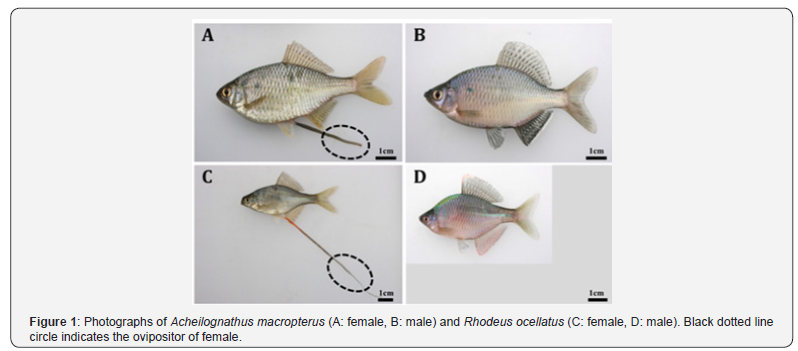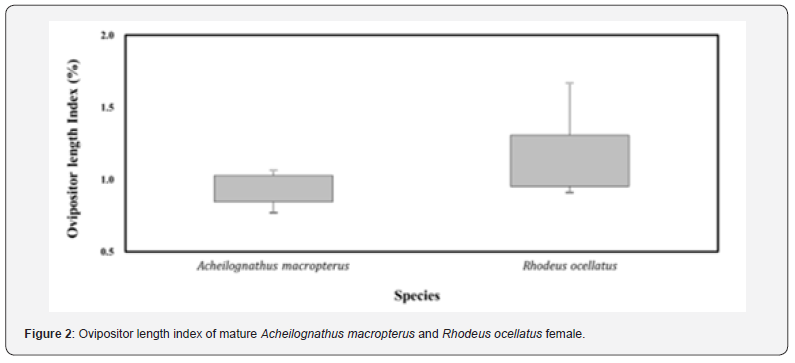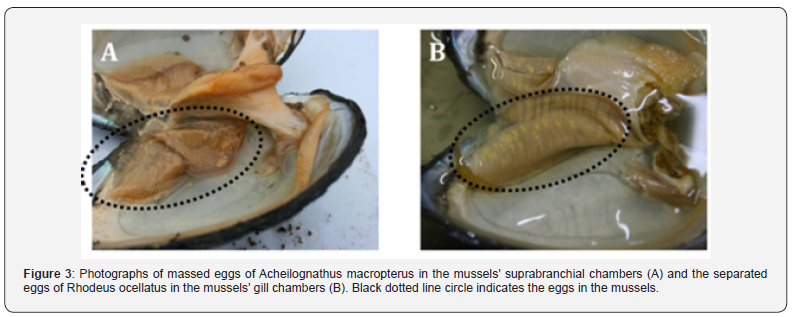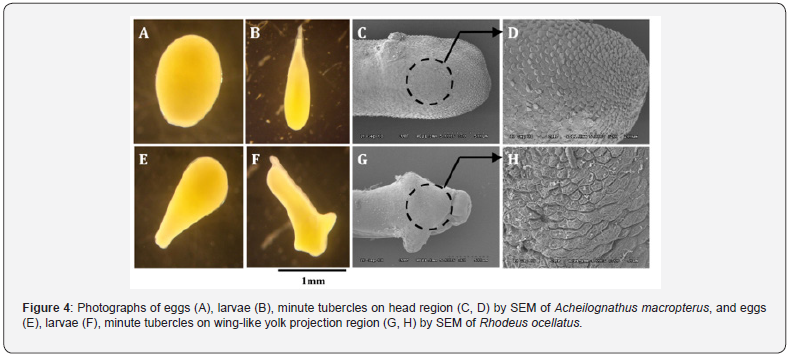Host selection and Change of Skin Surface for Spawning Adaptation of Two Sympatric Bitterling Species- Juniper Publishers
Juniper Publishers- Open Access Journal of Annals of Reviews & Research
Host selection and Change of Skin Surface for Spawning Adaptation of Two Sympatric Bitterling Species- Juniper Publishers
Abstract
Bitterlings (subfamily Acheilognathinae) are small cyprinid fishes with specialized spawning habits; they deposit their eggs on the gills of freshwater mussels using their ovipositors. This study on spawning host-selection in two sympatric bitterling species, Acheilognathus macropterus and Rhodeus ocellatus, was conducted in the Bulgapcheon Stream, Korea, where four mussel species coexisted. After analyzing the four mussel species immediately after spawning, we discovered that the two bitterlings used only two mussel species as their spawning hosts, Anodonta arcaeformis and A. woodiana. Embryos of A. macropterus were predominantly found in the suprabranchial chambers of the two mussel species, and the larvae were even seen in their gill chambers. In contrast, the embryos and larvae of R. ocellatus were almost exclusively found in one region of the mussel gill chamber, unlike the two regions used by A. macropterus. The findings of this study suggest that the relationships between bitterlings and their hosts are closely associated with several factors such as ovipositor length, egg sizes, egg adhesiveness, and the coexisting mussels’ ecological habitat.
Keywords:Acheilognathinae, bitterling, freshwater mussel, host selection, host-parasite
Introduction
Approximately 60 species of bitterlings (Cyprinidae, Pisces) have been described from Southeast Asia, mainland China, Japan, and Europe, of which 14 species are found in Korea [1]. During the spawning season, females develop a long ovipositor, which they use to lay eggs in the gill cavities of mussels through the mussel’s exhalant siphon. Males have bright nuptial coloration and they defend territories around living freshwater mussels. Males eject their sperm into the inhalant siphon of the host mussels so that fertilization occurs within the gill cavities of mussels. The embryos develop inside the mussels for 3–4 weeks until the yolk sac is absorbed; thereafter they enter the free-swimming stage [2]. Oviparous fishes with parental care utilize different reproductive strategies to select spawning sites to increase the survival rate of larvae. Although bitterlings do not have parental care, they lay very few eggs. It is difficult for the bitterlings to lay their eggs inside mussels, but the strategy ensures that the larvae can spend their early developmental stage safely inside the mussels. The relationship between bitterlings and mussels is a notable example of coevolution [3].
Glochidia, the larvae of some freshwater mussels are obligate ectoparasites of fish. Glochidia are usually brooded in the outer demibranch of the mussels some species use inner and outer demibranchs. After attachment to the gill and fins of fish, the glochidia are encysted by fish tissue and survive for several days. This development strategy enables glochidia to disperse. The bitterling-mussel relationship is thought of as a mutualistic relationship; bitterlings use mussels as spawning hosts, while mussels take advantage of bitterlings to disperse their glochidia. However, there is increasing evidence that the bitterling-mussel relationship, at least in some species, may not be mutually beneficial and incurs costs for both partners [4]. Recent studies showed that the bitterling-mussel relationship is, in fact, a type of host-parasite interaction [2]. The bitterlings make sophisticated oviposition decisions to prevent ejection and have several unique physiological, behavioral, and morphological adaptations for spawning on host mussels. These adaptations include different ovipositor lengths, the development of minute tubercles on the skin surface, and the spatial utilization of host mussels. This purpose of this study focuses on the reproductive ecology and host selection of two sympatric bitterling species, Acheilognathus macropterus and Rhodeus ocellatus to elucidate the relationship between bitterling and mussels.
Discussion
Reproductive ecology and host selection of the two bitterling species, Acheilognathus macropterus and Rhodeus ocellatus, differ from each other regarding their ovipositor length. R. ocellatus has a longer ovipositor than A. macropterus. Mortality of bitterling larvae occurs because of two main causes: premature ejection by the mussel and death in the mussel gill from asphyxiation or nutrient deficiency. The long ovipositor of R. ocellatus and the large size of the eggs ensure that they fit properly into the interlamellar space of the demibranchs in the mussels (Figure 1). A longer ovipositor allows eggs to be deposited deeper within the mussels’ gill cavities, reducing competition for space and oxygen between the deposited eggs [5]. In contrast, A. macropterus has a shorter ovipositor, and the species lays eggs in a mass form on the mussels’ suprabranchial chambers, thus preventing premature ejection (Figures 2 & 3). Because of their differences in reproductive ecology, the two bitterling species appear to be able to coexist in Anodonta arcaeformis. The present study suggests that different oviposition sites may reduce their competition for space. Furthermore, the two bitterling species seem to have their own strategies: R. ocellatus prevents premature ejection of larvae by spawning in the deeper part of the host mussel, with yolk sac projections, whereas A. macropterus deposits egg in a mass and let them hatch earlier from the mussels.



Bitterlings make sophisticated oviposition decisions to prevent ejection. Their embryos vary in shape, number, and size, and four egg types have been recognized in Korea: bulb-like, pear-shaped, spindly, and ovoid; moreover, some eggs are sticky, which is an adaptive property to prevent premature ejection from mussels [6]. The bitterling larvae develop single-celled epidermal cells, called ‘minute tubercles’, on their skin surface, which are known to play an important role in preventing the larvae from being prematurely ejected from the mussels.
Minute tubercles are common in all developmental stages of bitterlings, even though their larval morphology is diverse. Previous studies have reported that minute tubercles are mainly developed in the frontal part of the larvae and on the eyes of the larvae, forming a wing-like projection. The egg type of A. macropterus is ovoid with type-B projections and R. ocellatus is bulb-like with type-C projections [7]. Consequently, the shape of eggs and the minute tubercle differ in these two sympatric bitterling species to avoid the interspecific competition (Figure 4). The minute tubercle is a unique feature in bitterling species, and as wing-like projections exist in Rhodeus but not in Acheilognathus and Tanakia, they have been used as a taxonomic characteristic to differentiate the Acheilognathinae genera [8]. The minute tubercle in Acheilognathus and Tanakia bitterling species, which do not have a wing-like projection, tend to develop in the foremost part of the head, and the form of the yolk projection is scaly or hilly, which is different from that of Rhodeus bitterlings. The development of larger and sharper minute tubercles in Acheilognathus and Tanakia larvae compared to those of Rhodeus larvae (20–40 μm vs. 3–15 μm) is an adaptation strategy that also prevents premature ejection and allows the larvae to fit tightly into the interlamellar space of the hosts’ demibranchs. The change in the height of the tubercles on the surface of the larvae is related to the position of the larvae in the mussels and may play an important role in preventing premature ejection by the host.

Conclusion
Bitterlings have a remarkable early life history. They lay a small number of eggs, develop unique tissue structures called minute tubercles during the early stages of larval development, have a very fast hatching time, and have a unique trait of laying eggs in mussels. This taxon has evolved various characteristics, such as maturation type, development, spawning type, larval migration in mussels, and host selection. Thus, an in-depth study could enhance our understanding of the evolutionary advantages of the host selection, ovipositor length, egg shape, and development of minute tubercle to increase embryos survival.
To know more about Juniper Publishers please click on: https://juniperpublishers.com/aboutus.php
For more articles in Open
Access Journal of Reviews & Research please click on:
https://juniperpublishers.com/arr/index.php


Comments
Post a Comment